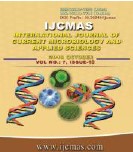


 National Academy of Agricultural Sciences (NAAS)
National Academy of Agricultural Sciences (NAAS)

|
PRINT ISSN : 2319-7692
Online ISSN : 2319-7706 Issues : 12 per year Publisher : Excellent Publishers Email : editorijcmas@gmail.com / submit@ijcmas.com Editor-in-chief: Dr.M.Prakash Index Copernicus ICV 2018: 95.39 NAAS RATING 2020: 5.38 |
The present paper estimate the cost and returns of sugarcane cultivation, input use efficiency and production constraints have been computed using primary data collected from 68 sugarcane growers on various aspects of costs and returns spread over two blocks in East-Champaran district of Bihar. The paper has analysed that an average sugarcane cultivating farmers in the area spent 33.71 percent of the total cost on hired labour, 21.72 percent on seed, 17.69 percent on chemical fertilizers, 11.98 percent on machine power and 4.26 percent on plant protection chemicals, realized a net return of Rs. 114183 per hectare. This might be due to the fact that the value of BCR has reached its maximum (2.74) only at the farm size of above two hectare. The study was shown that planting materials (seeds), tractor cost and plant protection chemical uses have a positive and significant influence on sugarcane yield, indicating that these resources are being used at sub-optimal levels and there exists the possibility of enhancing the yield of sugarcane by increasing their use. Labour shortage during peak period (81.50) average score in garret’s ranking has been reported the major production constraints by the sugarcane growers. The general observation from the farmer’s perception in the area is that in spite of the fact that the central and state Government price incentives have provided them a relief to some extent the mechanism evolved for fixing minimum price does not cover the entire cost components and the risk factors involved in the sugarcane cultivation.
 |
 |
 |
 |
 |